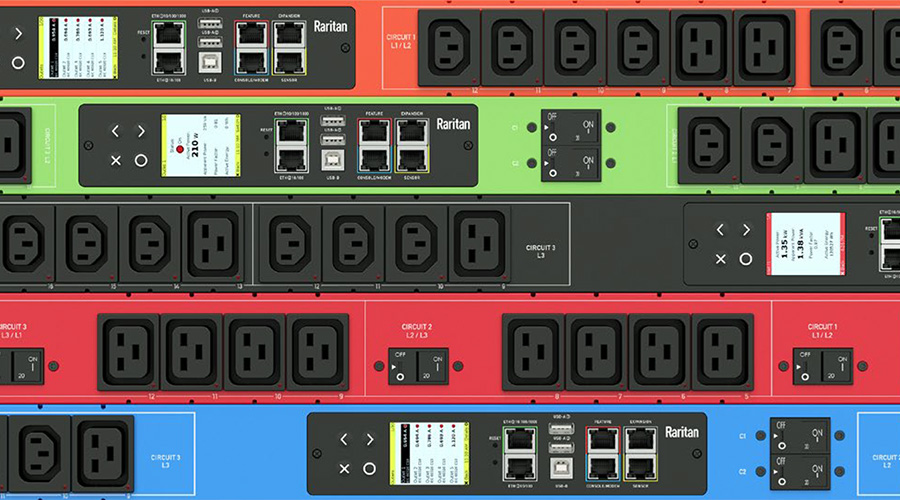SPONSORED
Server Technology - Branded Feature
Power Monitoring and Metering: How Understanding Power Consumption Can Lead to a More Efficient Data Center
Overview
Data center managers are continuously faced with the challenge
of providing increased levels of power in subsequently reduced
areas of space. They must achieve these feats all while adhering
to budget constraints, maintaining mission critical levels of both
uptime and reliability, and reducing stress on existing data center
infrastructures. This seemingly impossible task is only made
possible by leveraging the right approach to power monitoring at
the outlet, circuit breaker, and inlet levels. Unfortunately, far too
many businesses opt for data center solutions that use outdated
power monitoring solutions that are unable to provide the insights,
alerts, and fail-safes needed to create a scalable, reliable, and
agile IT infrastructure.
The following white paper will address how power monitoring
solutions can be effectively used to meet the aforementioned
demands, while simultaneously delivering an IT environment
that is able to achieve evolving business, usage, regulatory, and
financial goals
Where To Measure Power Consumption
In every data center there are several key locations where power
usage can and should be measured. A failure to accurately measure
power data in the following locations can result in unplanned
outages, reduced operating efficiencies, and higher costs.
1. Power Entering The Data Center. In a stand-alone structure,
it is typically a simple task to measure the data center's PUE.
However, far too often, data centers exist as a floor within a
building. In the latter instances, a submeter should be installed
for the floor to accurately measure the total power number for the
data center.
2. Uninterruptible Power Supply (UPS). The UPS should be
measured. In instances where the UPS is only providing power to
IT equipment, then it can be used as the denominator for the vital
PUE calculation. With this in mind, it is important to note that the
UPS might also be providing power to the data center's rack-based
cooling equipment, which means that additional considerations
must be made before it can be used in a PUE calculation.
3. Panel and Floor Measurements. Floor-mounted power
distribution unit (PDU) provides an important management bridge
between a building's primary power and various equipment racks
within a data center. Each PDU can handle larger amounts of
energy than an ordinary power strip and typically provides power to
multiple equipment racks.
4. Rack-based Power Measurements. Through metered rack
power distribution units (PDUs) the power consumption of specific
racks can be measured.
5. Individual Outlet Measurements. The power used at the
individual outlets of a rack PDU should be measured. Intelligent
PDUs can be used to monitor the power consumption at the outlet
level to increase efficiencies and improve uptime.
How is Power Data Gathered
in a Data Center?
Measuring and monitoring power data is vital to the IT health of a
data center. Without these vital measurements, data centers are
more susceptible to higher levels of outages, increased downtime
occurrences, higher costs, and in some instances potential damage
to the actual IT infrastructure. To avoid these issues, data centers
can instead deploy the following solutions to effectively monitor
power consumption at the outlet, circuit breaker, and inlet levels.
Basic PDUs
Basic PDUs are an affordable and proven technology. They are
typically power strips constructed from high quality components
and can be used to support the correct voltage and current distribution to several outlets at once. The downside of a basic PDU is
that it doesn't have the instrumentation needed to provide valuable
power monitoring insights. Additionally, basic PDUs cannot be
remotely managed.
Intelligent PDUs
An intelligent rack PDU is a device that features remote accessibility and management. It provides power monitoring at both
the PDU level as well as the individual outlet level. Additionally,
it is designed to provide specific user defined threshold alerts,
so that data center managers can more effectively monitor their
entire data center from on-site or remote locations. These highly
customizable power monitoring devices also feature remote power
on / off capabilities, outlet level switching, real time environmental
data analysis, and the ability to be easily integrated with existing
directory servers.
There are four typical types of intelligent PDUs that can assist with
data center power monitoring.
1. Metered Inlet PDUs. This type of intelligent PDU measures
power consumption at the inlet-level. The gathered data can be
displayed locally and over a secure network.
2. Metered Outlet PDUs. This type of intelligent PDU features the
same capabilities as a metered inlet PDU, while also providing
metering at the outlet level. Once again, the gathered data can be
displayed locally and over a secure network.
3. Switched PDUs. This type of intelligent PDU features the same
capabilities as an inlet PDU, while also enabling authorized users
to securely power-cycle outlets from remote locations. Through
remote power-cycle, energy can be conserved, devices can be
rebooted more easily and effectively, services can be efficiently
restored in the event of an outage, unauthorized device provisioning is prevented, and inrush currents are minimized.
4. Switched PDUs With Outlet Metering. This type of intelligent
PDU combines all the aforementioned capabilities of both the
switched PDUs and outlet metered PDUs.
For the majority of data centers, intelligent PDUs are the optimal
power monitoring solution to reduce costs, increase energy
efficiencies, improve availability, and manage the existing capacity
of the entire data center.
Branch Circuit Monitors and
Individual Device Load Measurement
Branch circuit monitors are incredibly important to effectively
measure power consumption across the data center. Typically, these
electrical devices are designed to measure the current load for
each circuit on a designated electrical panel. The devices will alert
operators when the current load is approaching the breaker's designated rating. This heightened level of power monitoring is especially
important in data centers where additional servers can accidentally be
plugged into a circuit that is close to its designated operating capacity.
Finally, branch circuit monitors can be used to continuously measure
current across circuits, so that trips, outages, and overloads can be
avoided, and the optimal levels of uptime can be enjoyed.
Overhead Busway Systems
Overhead busway systems are an alternative to panels to deliver
power. Monitoring solution can also be used in conjunction with
busway system to help provide operators exact power usage. All
too often when new equipment is added to a rack, the cable ratings
can be exceeded, which can subsequently trip circuit breakers and
cause unexpected power outages. Fortunately, an overhead busway
system is designed to provide power feed monitoring in real time,
so that data center managers can more effectively plan for the
installation of new equipment at the rack level. This heightened level
of monitoring can also help data center managers ensure that the
data center's electrical system is properly balanced across phases
so that increased savings and energy efficiencies can be enjoyed.
What Other Factors Contribute to
Power Consumption in the Data Center?

Environmental Sensors
Another major contributor to power consumption in a data center is their
HVAC system, which can sometimes be overlooked but plays a crucial role in
energy consumption. That's why is important to have environmental sensors
deployed in your data center. At their core, environmental sensors are designed
to improve power efficiencies across the data centers. These sensors can be
placed at the bottom, middle, and top portions of the racks on the cool air inlet
side to ensure that IT equipment is cooled to the appropriate levels. When IT
equipment is overcooled, it can not only consume additional power, but it can
increase operating costs without providing any type of additional benefit. Thus,
environmental sensors play a key role in providing not only power monitoring
solutions, but also reducing the overall operating costs within a data center.
What Benefits Does Power Monitoring Deliver
Within a Data Center?
By using the right power monitoring tools, data centers can not only enjoy
lower operating costs, but also reduce unexpected outages, optimize device
power consumption, and more effectively manage the entire data center. In
this vein, it is vital that data center managers take the time needed to install
devices that can monitor power at the outlet, circuit breaker, and inlet levels.
Additionally, individual devices should be monitored at regular intervals to
ensure that peak periods are not accidentally overlooked. Through individual
device power consumption data, managers will be able to more effectively
configure racks so that the equipment power consumption patterns complement each other and thus avoid tripping a breaker, while simultaneously
maintaining the optimal load levels.
As part of their power monitoring solutions, data center managers should
leverage intelligent PDUs. As was discussed previously within this white paper,
intelligent PDUs have the unique capability to effectively measure power
consumption at the inlet and individual outlet level. As part of these capabilities, intelligent PDUs can provide kilowatt usage data that can be combined
with CPU utilization data to determine which individual servers can handle
additional capacity. These insights are needed to improve overall data center
efficiencies through the effective redeployment or decommissioning of servers.
Finally, intelligent PDUs combined with environmental sensors can provide
the power monitoring solutions needed to improve server uptime, reduce
overheating (and overcooling), and provide a complete picture regarding the
air flow in and around each server. The latter power data insights are vital to
increasing uptime, reducing outages, and lowering operating costs.

Conclusion
Metering at the inlet, outlet, and circuit levels is vital to determining the power usage across an entire data center. Metering
at the inlet level not only helps data center managers effectively
determine the power usage and available capacity of a rack, but
it can reduce the risk of overloading circuits. Inlet level power
monitoring also allows data center managers to more easily
calculate PUE. Metering at the rack PDU circuit breaker levels
is vital to achieving an early warning system. This type of power
monitoring provides data center managers with the alerts needed
to avoid tripping a circuit breaker. It also provides the information
needed to effectively reduce power demands (as needed when the
circuit breaker is at lower usage levels). Metering at the outlet
level can not only help data center managers determine the power
usage and available capacity at the rack, it can also provide vital
insights into the power consumption levels at the device and / or server level. The latter insights are vital to identifying underutilized
servers, allocating costs, and identifying ghost servers.
In conclusion, through the right power monitoring tools, data
center managers can more effectively run a data center. By
accurately identifying servers that are running too hot or too cold,
data center managers can more readily save energy, avoid server
crashes, redeploy or decommission servers, balance power usage
(across servers and the entire data center), and identify opportunities to change or grow. In this vein, through the right combination
of tools, data center managers can more effectively measure and
understand power data to increase the effectiveness of IT operations and the allocation of resources.
To learn more about how power monitoring solutions can be
effectively leveraged at the inlet, outlet, and circuit breaker levels,
visit our PX Intelligent PDUs website.
About Raritan
Raritan began developing KVM switches for IT professionals to manage servers remotely in 1985. Today, as a brand of Legrand, we are a
leading provider of intelligent rack PDUs. Our solutions increase the reliability and intelligence of data centers in 9 of the top 10 Fortune
500 technology companies. Learn more at Raritan.com










